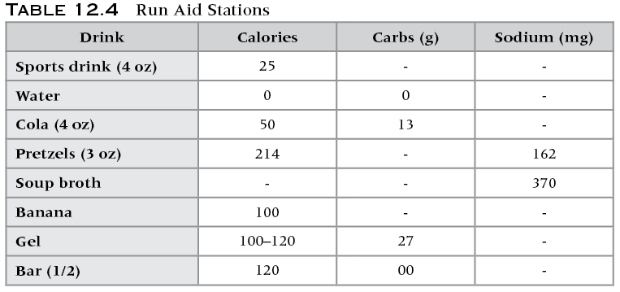Realize that the goal of race nutrition is not to stuff as many calories into your body as possible but rather to optimize the calories needed, giving yourself the least amount necessary to achieve your goal. This amount should be practiced in your specific training phase, so you know what your needs are. The more calories you put into the stomach, and the higher the concentration levels of calories, along with the higher the intensity of the bike ride, the more likely the stomach will not be able to handle the calories you give it. You must know the concentrations and caloric counts (carbohydrate grams as well) that you need to accomplish your goal. Going above and beyond those numbers or a range you can handle is flirting with GI disaster.
Many athletes claim a need to eat solid food on the bike because their stomachs give them a hunger craving. This is understandable and can be fine for some athletes, but this should be practiced, especially at race intensity.
The slower the speed or intensity of the bike leg for the athlete, the more food he or she can process in the stomach, and the more solid the food can be, since the demands on the rest of the body are lower. See tables 12. 2 and 12.3 for more guidance on what type of nutrition strategy is best for you, based on your speed.

Table 12.2 Bike Nutrition Guidelines for Half IRONMAN (70.3)

Table 12.3 Bike Nutrition Guidelines for IRONMAN
With this information, you are likely ready and prepared to nail your nutrition plan. But remember, no nutrition plan in the world can make up for poor pacing on the bike or run. Execution is just as important as preparation. If you've prepared for a certain plan, execute it.
Transition two (T2). What is the location of the dismount line? Will someone take your bike for you (typical in full IRONMAN races, not typical in 70.3), or will you need to rack your bike yourself? What landmarks will you use to find your spot? What is the exact path you will follow from dismount to run course start? If there is a changing tent, what will be done in the tent? Clothing change? Will you put on socks? Sunscreen? GPS watch? (I recommend recording the race.)
Run pacing. How will you pace the run? How does this compare with your training paces? What will be your first mile or first 1 to 2K? How will the course profile likely affect pacing? Is it usually windy on the course? How will the temperatures and conditions affect this decision? More on run pacing shortly.
Run nutrition. What will you use to get your calories and grams of carbohydrate on the run? How many will you consume per hour? What is that per aid station? How many aid stations are there? What will the aid stations be providing? How many calories do these items offer? See tables 12.4 and 12.5 for guidance on calories.
Again, you can go over or under these guidelines, but your chances of success are high if you're within these ranges. If you go outside these ranges, be sure to prove in your training that it will work well for you.

Table 12.4 Run Aid Stations

Table 12.5 Nutritional Guideline Ranges for Long-Course Triathlon Run Legs
Finalize the plan. If you can go through each of these segments of the race and write a plan, chances are you will execute much better. The amount of time and energy invested in training can be wasted if execution is poor, so this exercise can really pay off. In chapter 14, Postrace Analysis, this written plan becomes even more important because you will take each of these sections and compare them directly with what happened in the race. This will create an even better race learning experience, to help make you better at your preparation and execution.
Excerpted from Triathlon 2.0 by Jim Vance. ©2016. Reprinted with permission from Human Kinetics.
All rights reserved. No reproduction, transmission, or display is permitted without the written permission of Human Kinetics, Inc.
Connect with us on Twitter, Facebook, Instagram or Pinterest for more tips, recipes and ideas to fuel your ACTIVE life.
 Find your next race.
Find your next race.
- 3
- of
- 3








Discuss This Article